1. 203.移除链表元素元素
思路:创建一个哨兵位指向head,创建一个cur临时指针,遍历链表,遇到等于val的节点跳过即可,最后返回sentinel->next即链表的头节点
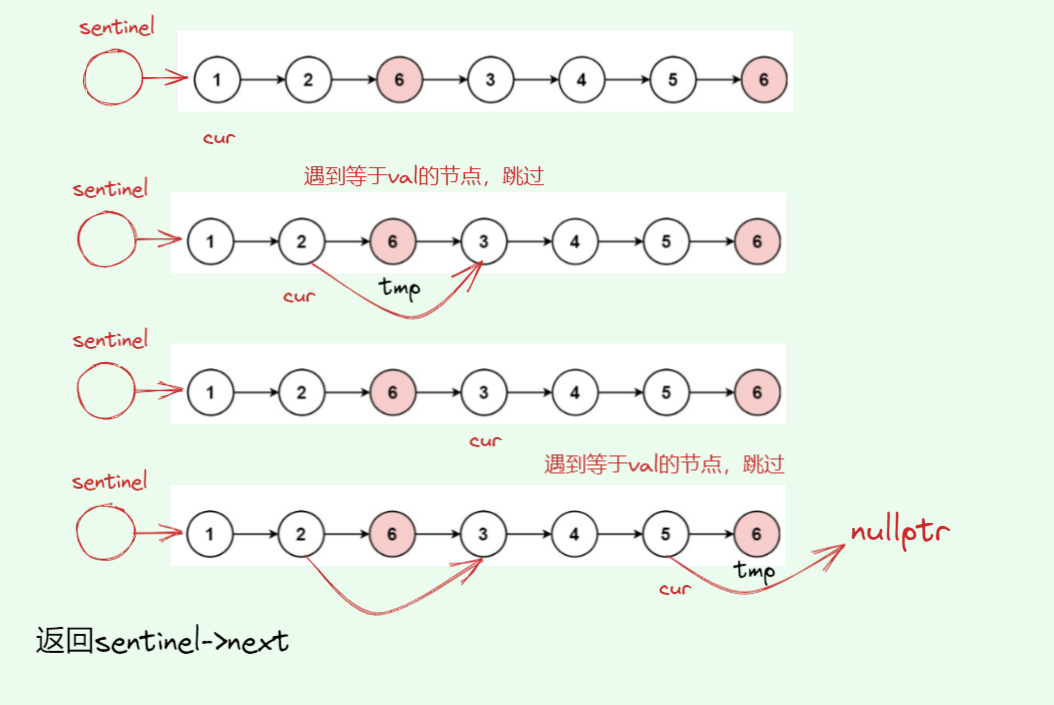
创建一个哨兵位就避免了讨论head是否为空
代码实现:
class Solution {
public:
ListNode* removeElements(ListNode* head, int val) {
// 创建哨兵位
ListNode* sentinel = new ListNode(-1);
sentinel->next = head;
// 创建临时指针遍历链表
ListNode* cur = sentinel;
// 遍历链表,跳过等于val的节点
while(cur->next){
if(cur->next->val == val){
ListNode* tmp = cur->next;
// 跳过tmp节点,并删除
cur->next = cur->next->next;
delete tmp;
}
else{
cur = cur->next;
}
}
// 创建返回值
ListNode* ret = sentinel->next;
delete sentinel;
return ret;
}
};
2. 206 反转链表
思路:创建三个指针n1 n2 n3,n1指向空,n2指向头,n3指向头的next,三个指针不断向后移动,改变原链表的指针指向
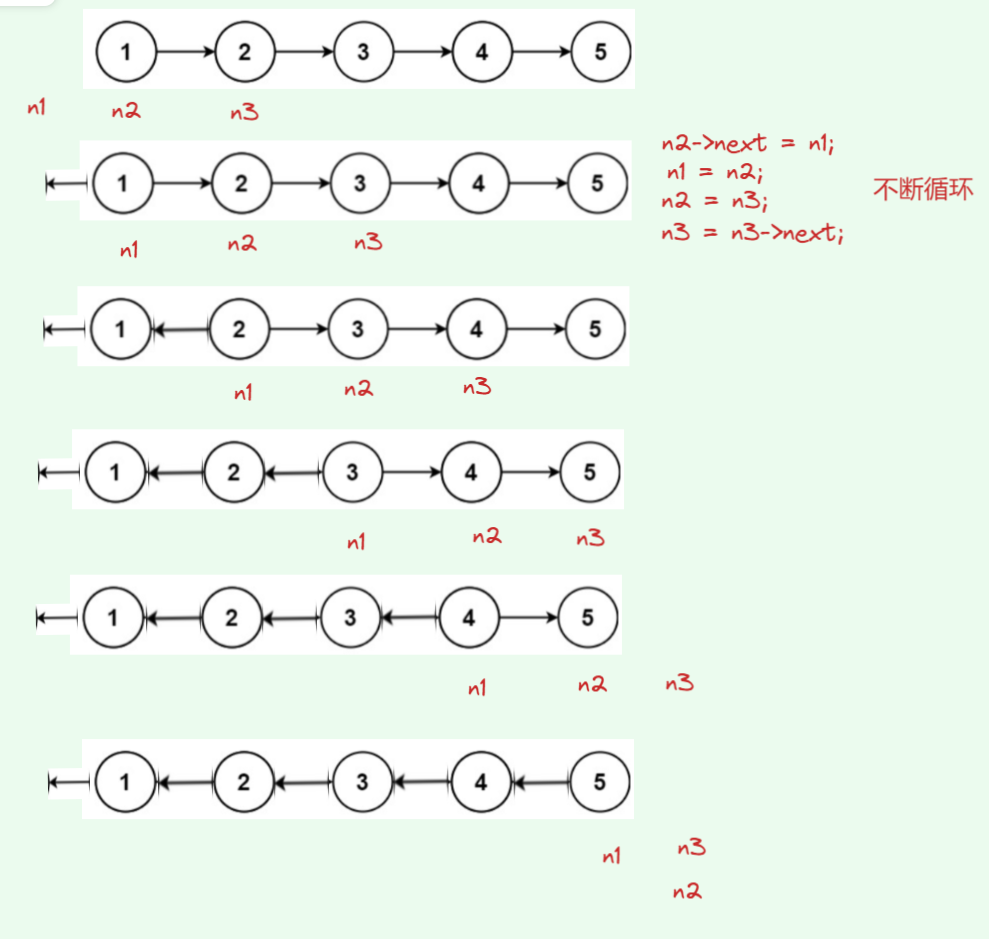
class Solution {
public:
ListNode* reverseList(ListNode* head) {
if(head == nullptr) return nullptr; // 考虑到链表为空的情况
// 创建三个指针
ListNode* n1,*n2,*n3;
n1 = nullptr;
n2 = head;
if(head->next) n3 = head->next;
while(n2){
n2->next = n1;
n1 = n2;
n2 = n3;
// n3走到空之后就没有必要继续走了
if(n3) n3 = n3->next;
}
return n1;
}
};
注意循环条件的控制:n2走到空就结束循环,而n3的移动由自己控制,n3在最后,如果走到空,就不能再往后走了,停止移动即可
3. 876 链表的中间节点
思路:快慢指针法,快指针走两步,慢指针走一步,形成了距离差,快指针走到空,慢指针所在位置即是中间节点
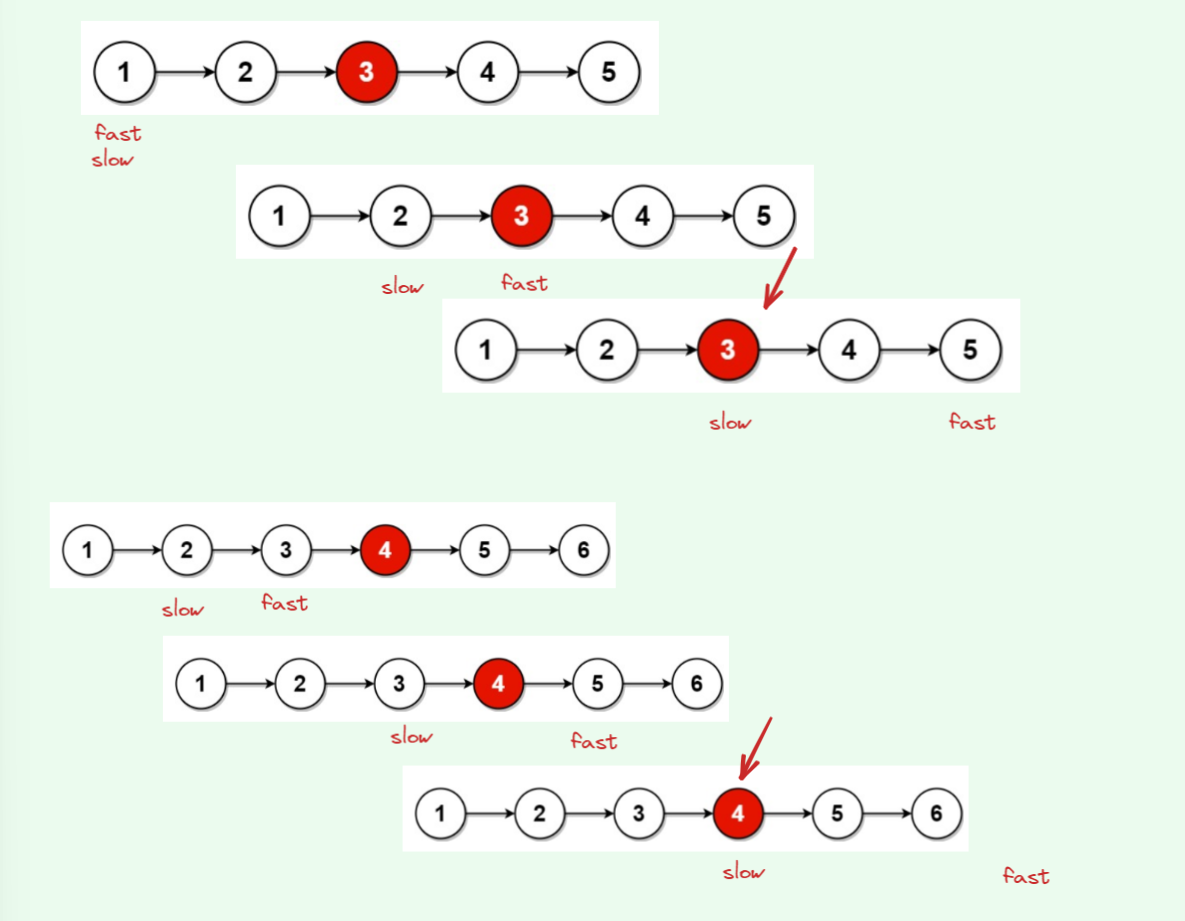
class Solution {
public:
ListNode* middleNode(ListNode* head) {
ListNode* fast, *slow;
fast = slow = head;
while(fast && fast->next){
fast = fast->next->next;
slow = slow->next;
}
return slow;
}
};
4. 21 合并两个有序链表
思路:创建一个带哨兵位的链表,同时遍历list1和list2,小的尾插到新链表上,注意:总会有一个链表先走完,另一个链表剩余节点尾插到cur之后即可
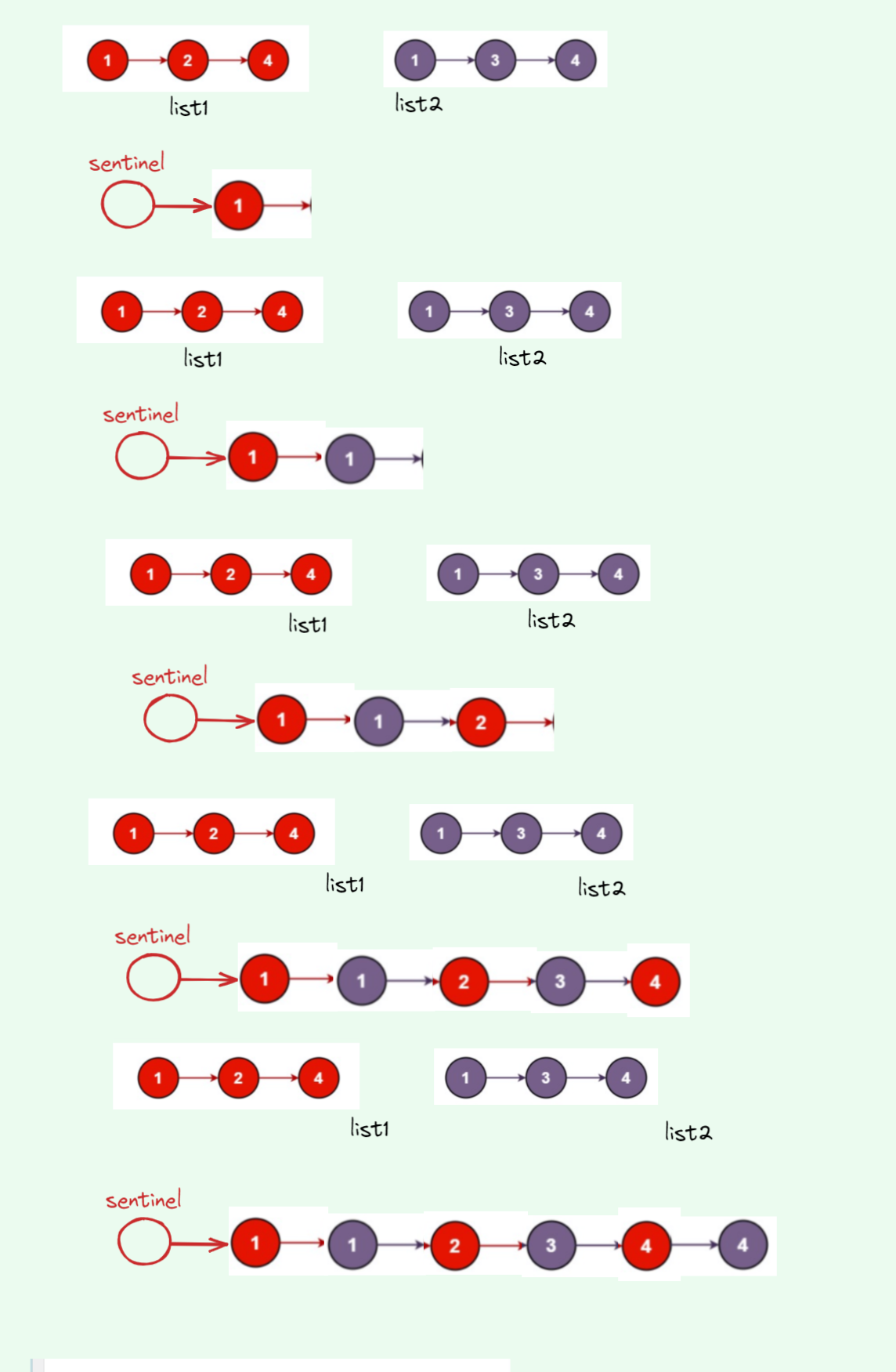
class Solution {
public:
ListNode* mergeTwoLists(ListNode* list1, ListNode* list2) {
ListNode* sentinel = new ListNode(-1);
ListNode* cur = sentinel;
while(list1 && list2){
if(list1->val <= list2->val){
cur->next = list1;
list1 = list1->next;
}else{
cur->next = list2;
list2 = list2->next;
}
cur = cur->next;
}
// 总会有一个链表先走完,另外一个链表剩余节点直接尾插到cur之后即可
ListNode* tail = list1 == nullptr ? list2 : list1;
cur->next = tail;
// 返回最后拼装的节点
ListNode* ret = sentinel->next;
delete sentinel;
return ret;
}
};
5. 面试题02.04 分割链表
面试题 02.04. 分割链表 - 力扣(LeetCode)
思路:创建一个大链表和一个小链表,遍历原链表,大于等于x的节点尾插到大链表,小于x的节点尾插到小链表,小链表的尾链接大链表的头
面试题.分割链表
class Solution {
public:
ListNode* partition(ListNode* head, int x) {
ListNode* sentinelB = new ListNode(-1);
ListNode* sentinelS = new ListNode(-1);
if(head == nullptr) return nullptr;
ListNode* cur = head;
ListNode* curB = sentinelB;
ListNode* curS = sentinelS;
while(cur){
if(cur->val < x){
curS->next = cur;
curS = curS->next;
}else{
curB->next = cur;
curB = curB->next;
}
cur = cur->next;
}
// 处理带环问题
curB->next = nullptr;
curS->next = sentinelB->next;
ListNode* ret = sentinelS->next;
delete sentinelB;
delete sentinelS;
return ret;
}
};
6. OR36 回文链表
思路:逆置后半段,比较两个链表是否相同,相同即是回文链表
- 找中间节点:快慢指针
- 逆置:三个指针改变链表指向
- 判断回文:遍历链表
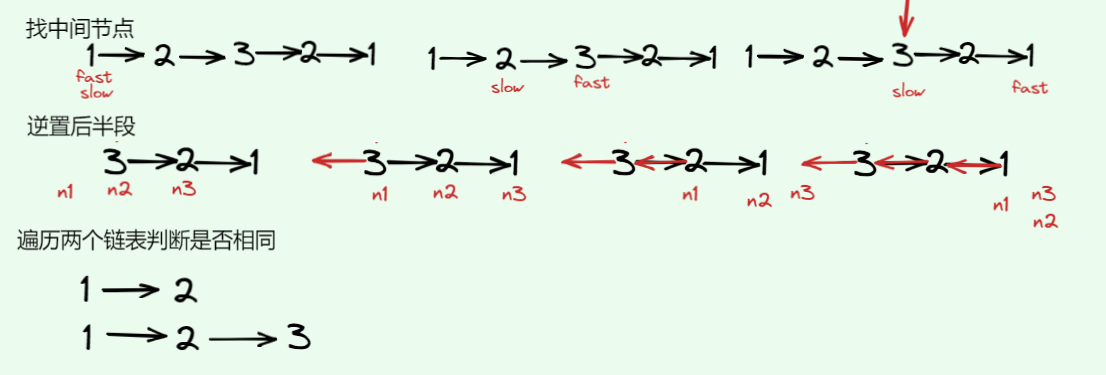
class PalindromeList {
public:
// 找中间节点
ListNode* midNode(ListNode* A){
// 空链表处理
if(A == nullptr) return nullptr;
// 快慢指针
ListNode* fast, *slow;
fast = slow = A;
while(fast && fast->next){
fast = fast->next->next;
slow = slow->next;
}
return slow;
}
// 逆置链表
ListNode* inverseNode(ListNode* A){
// 空链表处理
if(A == nullptr) return nullptr;
ListNode* n1,*n2,*n3;
n1 = nullptr;
n2 = A;
n3 = A->next;
while(n2){
n2->next = n1;
n1 = n2;
n2 = n3;
if(n3) n3 = n3->next;
}
return n1;
}
bool chkPalindrome(ListNode* A) {
// 找中间节点
ListNode* mid = midNode(A);
// 逆置后半段
ListNode* inversion = inverseNode(mid);
// 遍历两个链表
ListNode* curTail = inversion; // 后半段链表
ListNode* curHead = A;// 前半段链表
while(curHead && curTail){
if(curHead->val != curTail->val){
return false;
}
curHead = curHead->next;
curTail = curTail->next;
}
return true;
}
};
7. 160 相交链表

class Solution {
public:
bool isCrossing(ListNode* headA, ListNode* headB){
if(headA == nullptr || headB == nullptr) return false;
ListNode* curA = headA;
ListNode* curB = headB;
while(curA->next) curA = curA->next;
while(curB->next) curB = curB->next;
return curB == curA;
}
ListNode *getIntersectionNode(ListNode *headA, ListNode *headB) {
bool ret = isCrossing(headA, headB);
if(ret == false) return nullptr;
// 找两个链表的长度
size_t lenA = 0, lenB = 0;
ListNode* curA = headA;
ListNode* curB = headB;
while(curA->next){
++lenA;
curA = curA->next;
}
while(curB->next){
++lenB;
curB = curB->next;
}
// 长的链表先走长度查
size_t gap = std::abs(static_cast<long>(lenA - lenB));
ListNode* longList = headA;
ListNode* shortList = headB;
if(lenB > lenA){
longList = headB;
shortList = headA;
}
while(gap--) longList = longList->next;
// 现在两个链表同时走
while(longList != shortList){
longList = longList->next;
shortList = shortList->next;
}
return longList;
}
};
8. 141 环形链表
思路:快慢指针,快指针会先进环,慢指针后进环
如果链表带环,快指针一定会和慢指针相遇,反之则不会
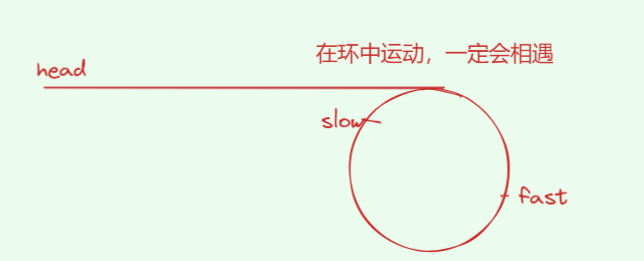
class Solution {
public:
bool hasCycle(ListNode *head) {
if(head == nullptr) return false;
ListNode* fast, *slow;
fast = slow = head;
while(fast && fast->next){
fast = fast->next->next;
slow = slow->next;
if(fast == slow) return true;
}
return false;
}
};
链表带环,fast走两步,slow走一步一定能追上吗?
fast先进环,slow后进环,假设slow进环时与fast距离为 N N N
每次运动,二者距离减一
这是二者距离变化:
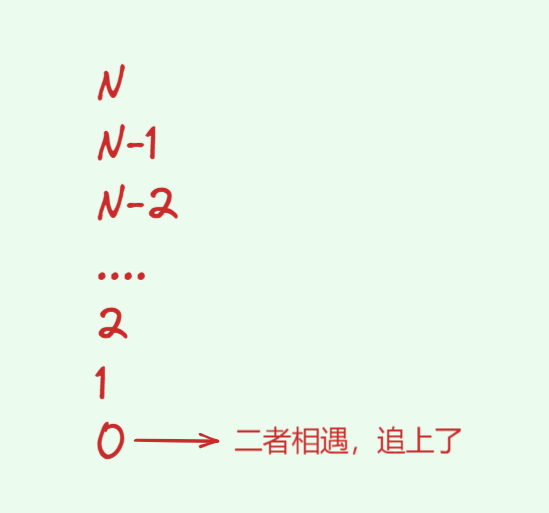
所以fast走两步,slow一定能追上
链表带环,fast走三步,slow走一步一定能追上吗?
fast先进环,slow后进环,假设slow进环时与fast距离为 N N N
每次运动,二者距离减二
这是二者距离变化:
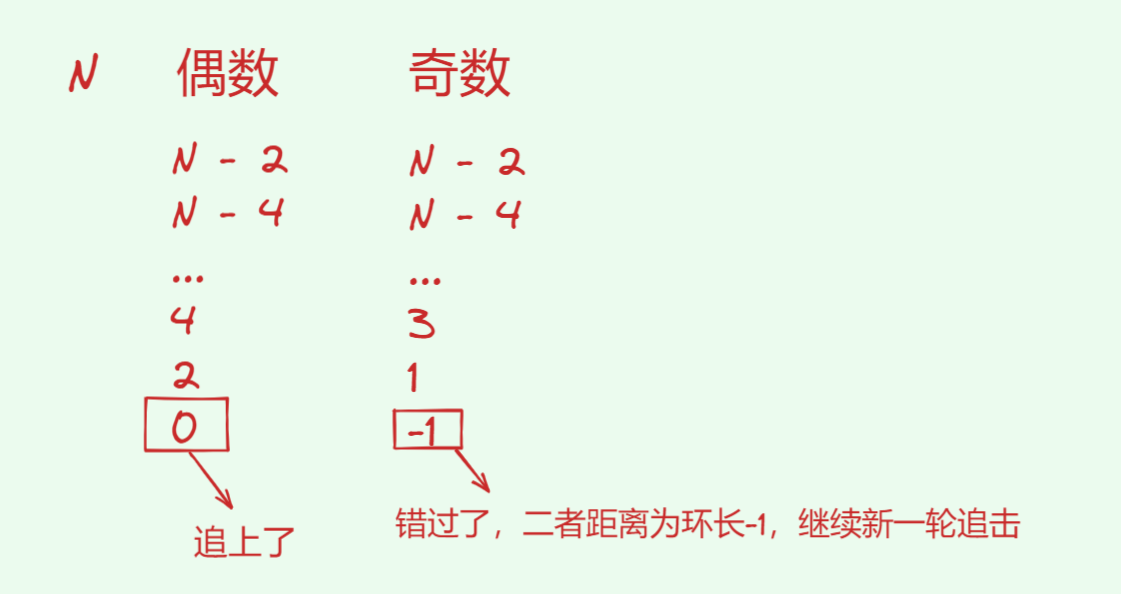
假设环长为 C C C,若 C − 1 C - 1 C−1为偶数,下一轮就追上了,若 C − 1 C - 1 C−1为奇数,则仍需分析
考略一下:永远追不上的条件: C − 1 C - 1 C−1为奇数并且 N N N为奇数
这个条件能成立吗?
我们先来看一道题铺垫一下:
假设链表头到环的入口点距离为 L L L,环长 C C C,入口点到相遇点距离 X X X
此时fast走两步,slow走一步
相遇时:
slow 走了 L + X L+X L+X,
fast已经绕环 x x x圈,fast走了 L + x C + X L+xC+X L+xC+X
fast走两步,slow走一步,二者可以得到距离关系:
L + x C + X = 2 ( L + X ) L+xC+X= 2(L+X) L+xC+X=2(L+X)
化简可得:
L = ( x − 1 ) C + ( C − X ) L = (x-1)C + (C-X) L=(x−1)C+(C−X)
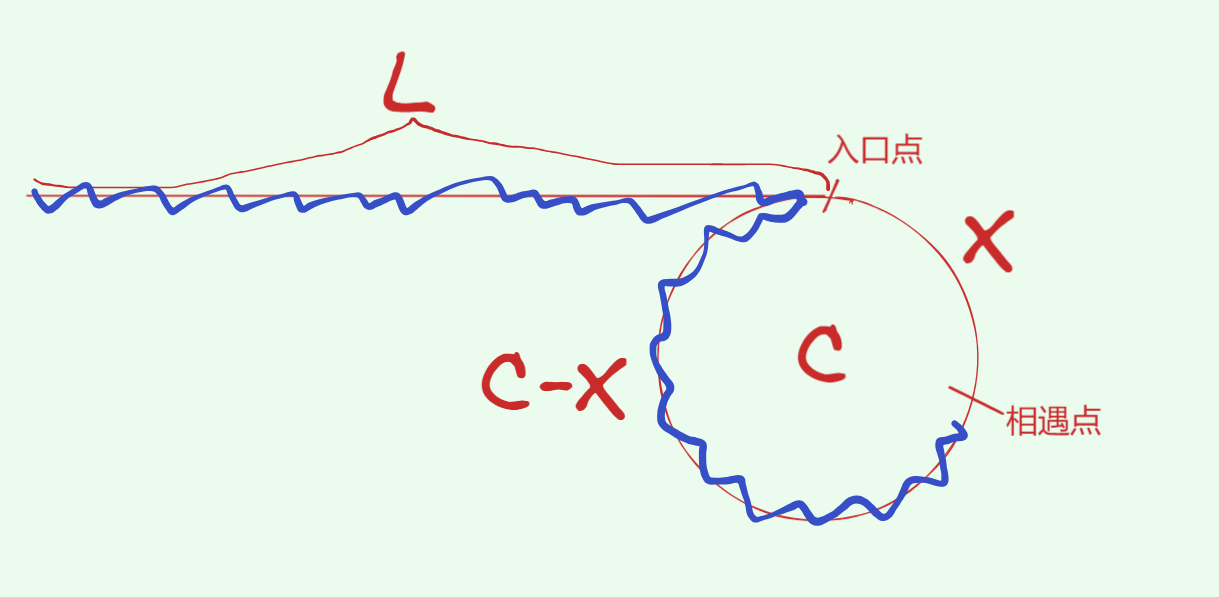
得到结论:一个指针从链表头开始走,一个指针从相遇点开始走,最终会在环的入口点相遇(两个指针走一样的步长)
所以,对于这道题目,先找相遇点,然后创建两个新的指针,一个从链表头开始,一个从相遇点开始,同时走,相遇的节点就是入口点
class Solution {
public:
ListNode *detectCycle(ListNode *head) {
// 处理空链表
if(head == nullptr) return nullptr;
// 创建快慢指针找相遇点
ListNode* fast = head, *slow = head;
// 相遇点
ListNode* meet = nullptr;
// 找相遇点
while(fast && fast->next){
slow = slow->next;
fast = fast->next->next;
if(fast == slow){
// 一个从链表头 一个从相遇点
meet = slow;
while(meet != head){
meet = meet->next;
head = head->next;
}
return meet;
}
}
return nullptr;
}
};
现在回到原来的问题,
fast走三步,slow走一步,永远追不上的条件: C − 1 C - 1 C−1为奇数并且 N N N为奇数成立吗?
假设链表头到入口点距离 L L L,环长 C C C,slow进环时,距离fast为 N N N,此时fast已经走了 x x x圈,并多走了 C − N C-N C−N
根据数量关系可得:
3 L = L + x C + C − N 3L = L + xC + C-N 3L=L+xC+C−N
化简得:
2 L = ( x + 1 ) C − N 2L = (x+1)C - N 2L=(x+1)C−N
C − 1 C - 1 C−1为奇数,那么 C C C就是偶数,任意数乘以偶数还是偶数, N N N为奇数
根据等式: 偶数 = 偶数 - 奇数 这是个错误结论!所以我们之前的设想:永远追不上的猜测是错误的,fast走三步,slow走一步也可以追上!
9. 138 随机链表的复制
思路:
复制原节点,构建拼接链表,例如:原链表为 n o d e 1 − > n o d e 2 − > . . . node1->node2->... node1−>node2−>... ,
构建拼接的链表就是 n o d e 1 − > n o d e 1 c o p y − > n o d e 2 − > n o d e 2 c o p y − > . . . node1->node1_{copy}->node2->node2_{copy}->... node1−>node1copy−>node2−>node2copy−>...

- 控制拷贝节点的
random:拷贝节点的random是原节点random的next
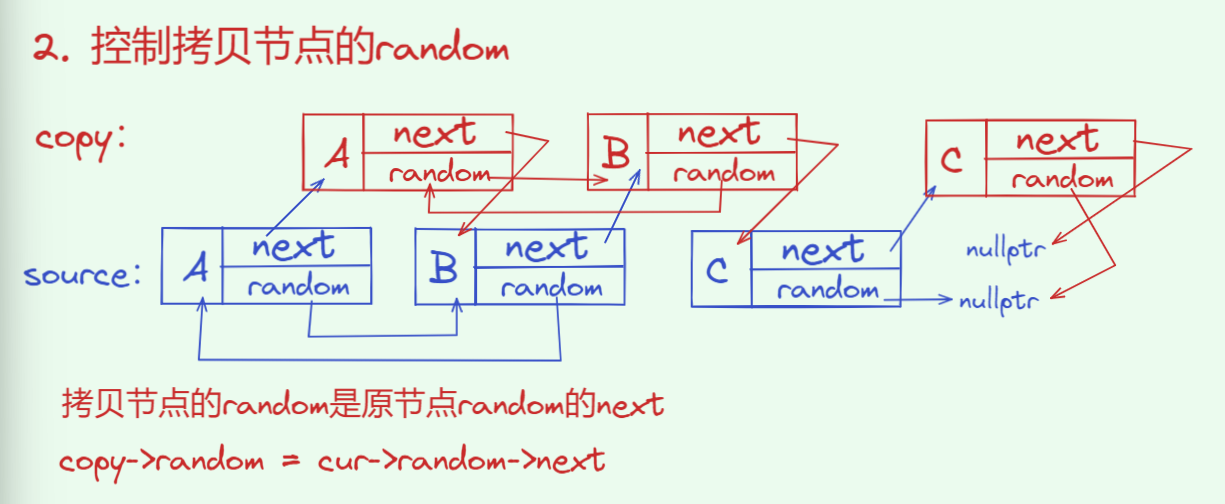
- 拆下拷贝链表,尾插形成拷贝链表,并恢复原链表
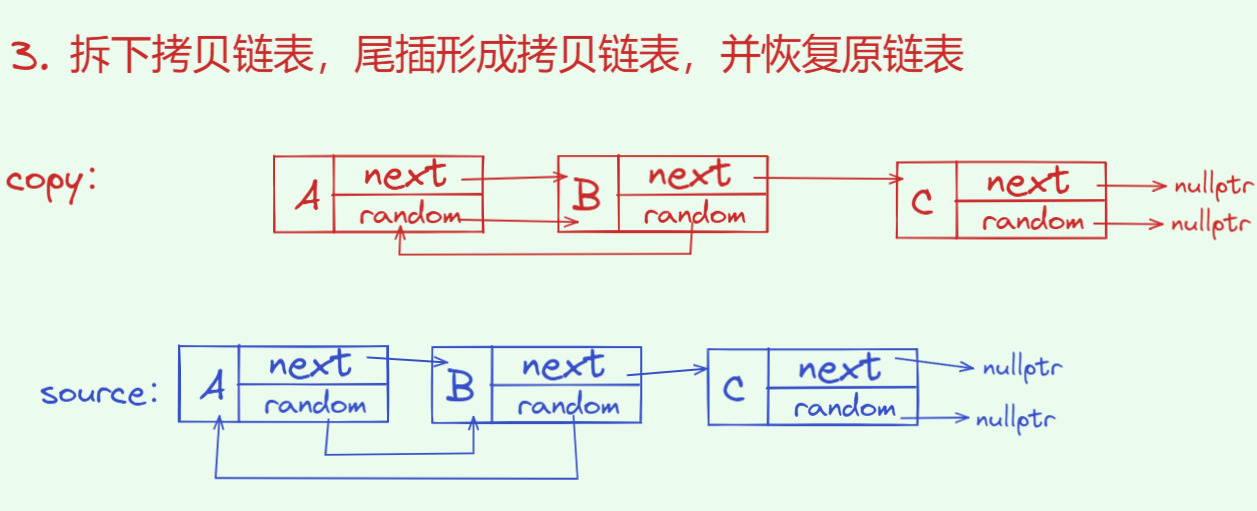
class Solution {
public:
Node* copyRandomList(Node* head) {
// 1. 复制节点
// 处理空链表
if(head == nullptr) return nullptr;
Node* cur = head;
while(cur){
Node* copy = new Node(cur->val);
copy->next = cur->next;
cur->next = copy;
cur = cur->next->next;
}
// 2. 控制拷贝节点的random
cur = head;
while(cur){
Node* copy = cur->next;
if(cur->random)
copy->random = cur->random->next;
cur = cur->next->next;
}
// 3. 拆下拷贝链表 尾插形成新链表 并恢复原链表
Node* sentinel = new Node(-1);
Node* copyCur = sentinel; // 用于构建新链表
cur = head;
while(cur){
Node* copy = cur->next;
Node* next = copy->next;
// 尾插
copyCur->next = copy;
copyCur = copy;
// 恢复原链表
cur->next = next;
cur = next;
}
Node* ret = sentinel->next;
delete sentinel;
return ret;
}
};